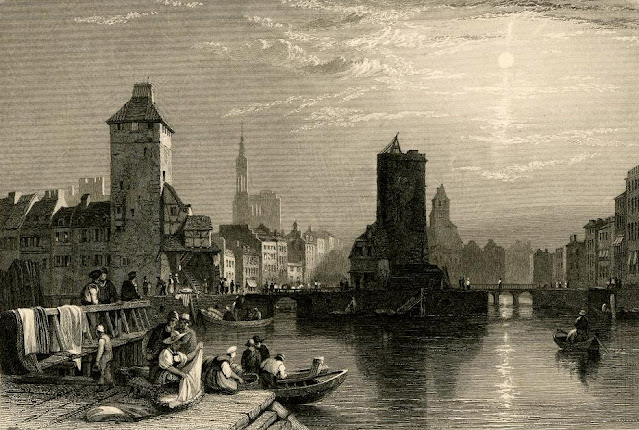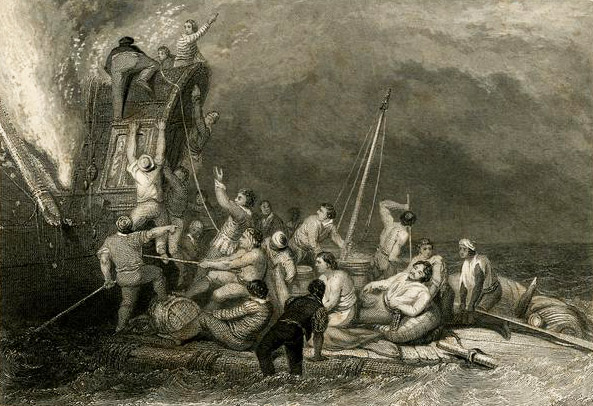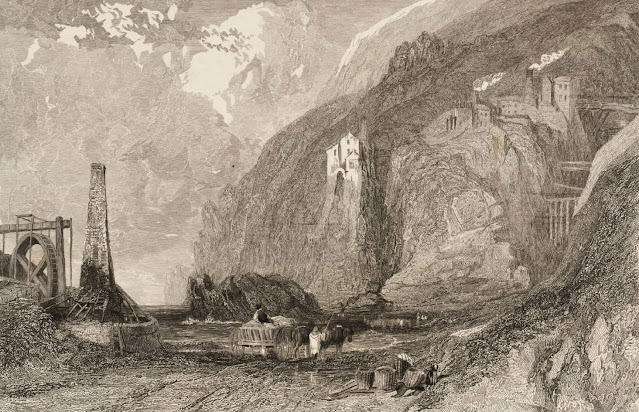 |
| Clarkson Frederick Stanfield albumen carte-de-visite © National Portrait Gallery, London |
Clarkson Frederick Stanfield went to sea at eleven to escape apprenticeship to a drunken coach painter, was pressed into the Royal Navy in 1812, then took up scene painting at the Royalty Theatre, London after being discharged for injury in 1816. Known for stunning romantic effects, often created in partnership with David Roberts, the artist introduced moving dioramas into Christmas pantomimes and Easter spectacles, titled "Adventures of a Ship of War" (1825), "Napoleon’s Passage of the Simplon" (1830) and "Niagara" (1832). While touring painted panoramas around major British and European cities, Stanfield contributed to the exhibitions of the British Institution and Royal Academy, and was elected Associate at the latter in 1835 through the support of the "Sailor King" William IV. In 1844, he became first curator of the Naval Gallery at Greenwich.
For a more comprehensive biography of Stanfield see part 1 , and for earlier works, see parts 1 - 4 also.
This is part 5 of a 7-part series on the works of Clarkson Frederick Stanfield:
1832 Heath's Picturesque Annual for 1832; North of Italy, the Tyrol, and the Rhine (after Clarkson Frederick Stanfield):
 |
| 1831 Heath's Picturesque Annual for 1832 etching and engraving on chine collé by William Miller |
 |
| 1831 Lac de Como line engraving 9.5 x 13.2 cm Royal Academy of Arts, London |
 |
| 1831 Schauffhausen etching and engraving by James Tibbetts Willmore © The Trustees of the British Museum |
 |
| 1832 Domo d'Ossola etching and engraving by Thomas Jeavins 15 x 22.6 cm |
 |
| 1832 Gallery of Gondo etching and engraving 22.7 x 15 cm © The Trustees of the British Museum |
 |
| 1832 Innsbruck etching by Charles Heath 13 x 18.2 cm |
 |
| 1832 Innsbruck. Principal Street etching by William Richard Smith |
 |
| 1832 Murano etching and engraving by Robert William Wallis 10.5 x 14.7 cm |
 |
| 1832 Near Feldkirk etching and engraving by Thomas Jeavons 11.3 x 14.9 cm |
 |
| 1832 Roveredo etching and engraving by James Tibbetts Willmore © The Trustees of the British Museum |
 |
| 1832 Sesto Calende etching and engraving by William Radclyffe © The Trustees of the British Museum |
 |
| 1832 Sti Gio e Paolo etching and engraving by James Tibbetts Willmore 15 x 22.8 cm |
 |
| 1832 Strasburg etching and engraving by Robert William Wallis 11 x 15.2 cm |
 |
| 1832 Tronsberg etching and engraving by James Tibbetts Willmore 22.7 x 15 cm |
 |
| c1832 Padua etching and engraving by Edward Finden 21.5 x 17.5 cm |
1833 Heath's Picturesque Annual for 1833; Travelling Sketches on the Rhine, and in Belgium and Holland (after Clarkson Frederick Stanfield):
 |
| 1832 The Castle of Godesburg near the Rhine engraved by Robert Wallis |
 |
| 1833 On the Scheld etching and engraving by Robert William Wallis 12.2 x 14.5 cm © The Trustees of the British Museum |
 |
| 1833 Cologne engraved by J.T. Willmore |
 |
| 1833 Near Bonn engraving by Charles Heath |
 |
| 1833 Rotterdam, Holland engraved by J. Carter |
 |
| 1833 Scheveling, Holland engraved by Robert Brandard 8.9 x 14.4 cm |
 |
| 1833 The Drachenfels near the Rhine engraved by Charles Heath 10.1 x 14.5 cm |
1833 Promenades d'un Artiste (after Clarkson Frederick Stanfield):
 |
| 1833 Andernach etching and engraving by Robert Brandard 13.2 x 9.7 cm |
 |
| 1833 Ehrenbreitstein, Prusse etching and engraving by Robert Brandard 13.1 x 9.5 cm |
1834 Heath's Picturesque Annual for 1834; Travelling Sketches on the Sea Coasts of France (after Clarkson Frederick Stanfield):
 |
| 1833 Castle of Heidelberg etching and engraving by James Tibbetts Willmore 11.9 x 17.9 cm |
 |
| 1833 Mont Saint Michel engraved by William Miller |
 |
| 1833 The Ramparts of St Malo etching and engraving, printed on chine collé bu Robert William Wallis 22.9 x 15 cm |
 |
| 1834 Harbour of St. Malo engraving by W. Floyd |
1834 Life and Poems of Rev. George Crabbe: title page etching and engraving made by Edward Finden (after Clarkson Frederick Stanfield):
 |
1834 Title Page etching and engraving by Edward Finden, after Frederick Clarkson Stanfield 17.5 x 11.4 cm |
 |
| 1835 The Happy-go-lucky etching by James Tibbetts Willmore 21.7 x 15.3 cm |
 |
| 1836 St Michael's Mount, Cornwall etching and engraving by A Le Petit 21 x 27.3 cm |
1835 The Pirate and the Three Cutters by Captain Marryat (after Clarkson Frederick Stanfield):
 |
| 1835 Cain in the Cavern etching and engraving by J.C. Edwards 15.3 x 22.8 cm © The Trustees of the British Museum |
 |
| 1835 Cave of the Caicos etching and engraving by J.C. Edwards 15.4 x 23 cm |
 |
| 1835 Rescuing the Crew from the burning Vessel etching and engraving by James Bayliss Allen 15.5 x 22.7 cm |
 |
| 1835 The Bay of Biscay etching and engraving on chine collé by Robert Brandard 15 x 22.5 cm |
 |
| 1835 The Happy-go-Lucky at St Maloe etching and engraving by James Tibbetts Willmore 21.5 x 15.2 cm |
 |
| 1835 The retreat of the Pirates etching and engraving by Robert Brandard 15.1 x 22.7 cm |
1836 Stanfield’s Coast Scenery (after Clarkson Frederick Stanfield):
 |
| 1836 Tréport engraved by E. Goodall line engraving on paper 12.5 x 10 cm Tate, London |
 |
| 1836 Falmouth, from the Mills etching and engraving on chine collé 17.2 x 14.4 cm |
 |
| 1836 Arched Rock, Isle of Wight engraved by W. Chevalier line engraving 9.5 x 13.8 cm Tate, London |
 |
| 1836 Botallack Mine, Cornwall engraved by W. Miller etching 9 x 14 cm Tate, London |
 |
| 1836 Boulogne, Old Pier engraved by E. Finden line engraving 9.5 x 13.8 cm Tate, London |
 |
| 1836 Boulogne, Upper Harbour engraved by W. Floyde line engraving 9.5 x 14.1 cm Tate, London |
 |
| 1836 Boulogne, Wreck on the Coast engraved by J. Carter line engraving 8.9 x 14.1 cm Tate, London |
 |
| 1836 Brading Harbour, Isle of Wight engraved by E. Finden line engraving 9.7 x 13.9 cm Tate, London |
 |
| 1836 Broadstairs engraved by J.C. Bentley line engraving 9.3 x 13.9 cm Tate, London |
No comments:
Post a Comment
Note: only a member of this blog may post a comment.